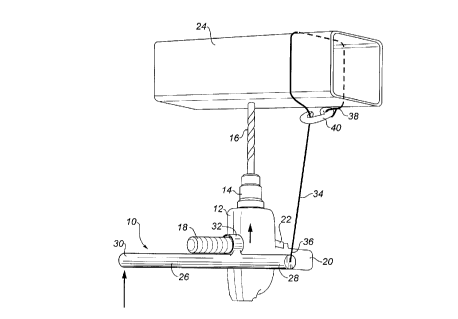Une partie des informations de ce site Web a été fournie par des sources externes. Le gouvernement du Canada n'assume aucune responsabilité concernant la précision, l'actualité ou la fiabilité des informations fournies par les sources externes. Les utilisateurs qui désirent employer cette information devraient consulter directement la source des informations. Le contenu fourni par les sources externes n'est pas assujetti aux exigences sur les langues officielles, la protection des renseignements personnels et l'accessibilité.
L'apparition de différences dans le texte et l'image des Revendications et de l'Abrégé dépend du moment auquel le document est publié. Les textes des Revendications et de l'Abrégé sont affichés :
| (12) Brevet: | (11) CA 2173424 |
|---|---|
| (54) Titre français: | DISPOSITIF POUR AUGMENTER LA PRESSION DANS UNE PERCEUSE MANUELLE |
| (54) Titre anglais: | APPARATUS FOR INCREASING HAND DRILL PRESSURE |
| Statut: | Réputé périmé |
| (51) Classification internationale des brevets (CIB): |
|
|---|---|
| (72) Inventeurs : |
|
| (73) Titulaires : |
|
| (71) Demandeurs : |
|
| (74) Agent: | WOODRUFF, NATHAN V. |
| (74) Co-agent: | |
| (45) Délivré: | 2000-05-16 |
| (22) Date de dépôt: | 1996-04-03 |
| (41) Mise à la disponibilité du public: | 1997-10-04 |
| Requête d'examen: | 1998-03-27 |
| Licence disponible: | S.O. |
| (25) Langue des documents déposés: | Anglais |
| Traité de coopération en matière de brevets (PCT): | Non |
|---|
| (30) Données de priorité de la demande: | S.O. |
|---|
Appareil pour accroître la pression d'une perceuse à main comprenant un levier muni d'une première et d'une deuxième extrémité. Un manchon, fixé transversalement sur le levier, à une certaine distance de la première extrémité, est conçu pour être glissé sur le manche d'une perceuse à main. Un fil d'ancrage est doté d'une première et d'une deuxième extrémité, la première est fixée sur la première extrémité du levier et la deuxième est équipée d'un crochet destiné à ancrer la corde d'ancrage à une pièce à travailler. Le levier fournit un gain mécanique, ce qui permet d'accroître la pression de la perceuse à main sur la pièce à travailler.
An apparatus for increasing hand drill pressure includes
a lever having a first end and a second end. A sleeve is
affixed transversely to the lever spaced from the first end.
An anchor line is provided having a first end and a second end.
The first end of the anchor line is secured to the first end
of the lever. A hook is provided on the second end of the
anchor line. The sleeve slides over a handle of a hand drill.
The hook is used to anchor the anchor line to a workpiece.
The lever provides a mechanical advantage to increase the
pressure with which the hand drill engages the workpiece.
Note : Les revendications sont présentées dans la langue officielle dans laquelle elles ont été soumises.
Note : Les descriptions sont présentées dans la langue officielle dans laquelle elles ont été soumises.

Pour une meilleure compréhension de l'état de la demande ou brevet qui figure sur cette page, la rubrique Mise en garde , et les descriptions de Brevet , États administratifs , Taxes périodiques et Historique des paiements devraient être consultées.
| Titre | Date |
|---|---|
| Date de délivrance prévu | 2000-05-16 |
| (22) Dépôt | 1996-04-03 |
| (41) Mise à la disponibilité du public | 1997-10-04 |
| Requête d'examen | 1998-03-27 |
| (45) Délivré | 2000-05-16 |
| Réputé périmé | 2013-04-03 |
Il n'y a pas d'historique d'abandonnement
Les titulaires actuels et antérieures au dossier sont affichés en ordre alphabétique.
| Titulaires actuels au dossier |
|---|
| HAMILTON, ROBERT LLOYD |
| Titulaires antérieures au dossier |
|---|
| S.O. |